Sir John Monash, Personal Files Book 13, 1 June - 1 July 1916, Part 9
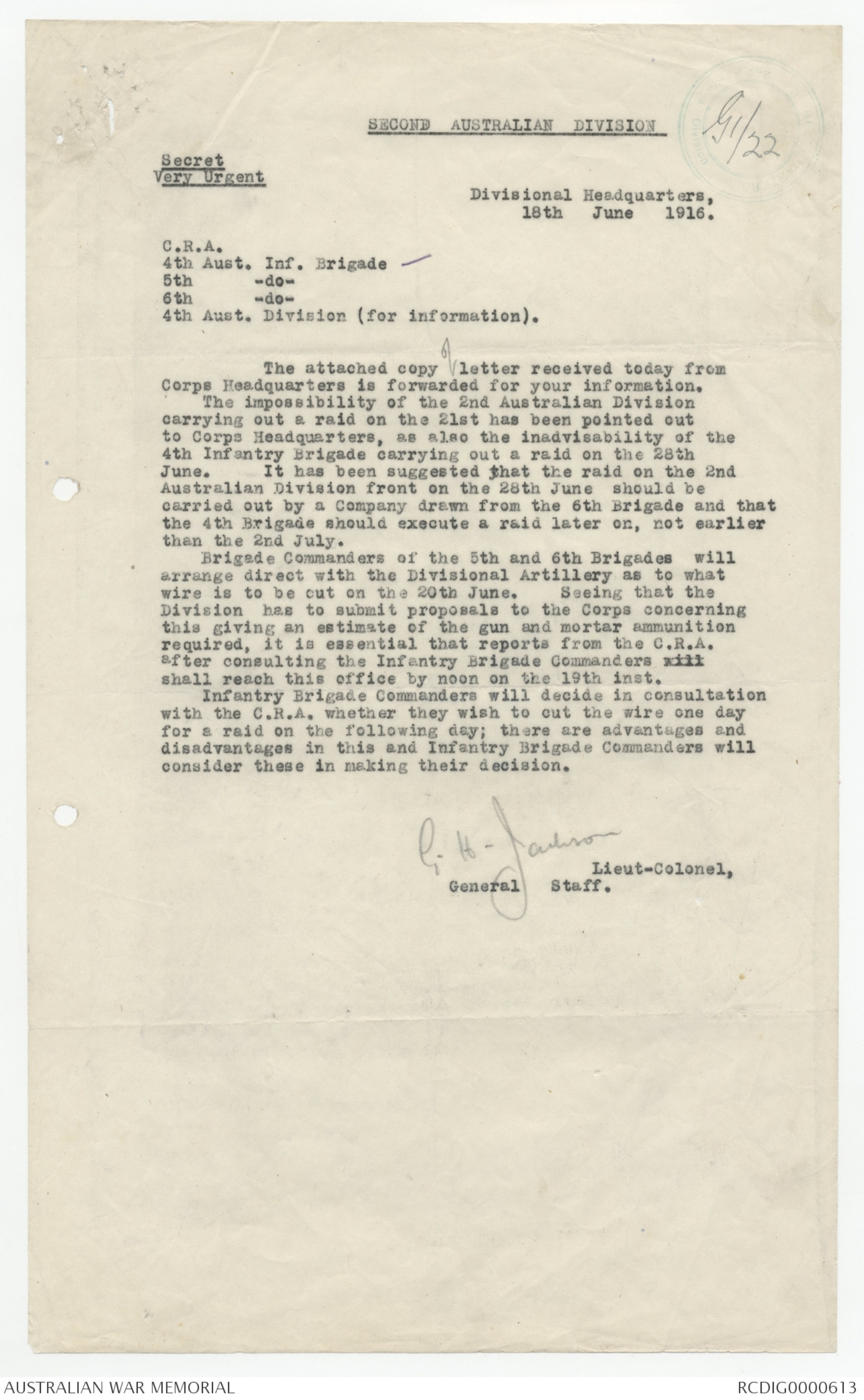
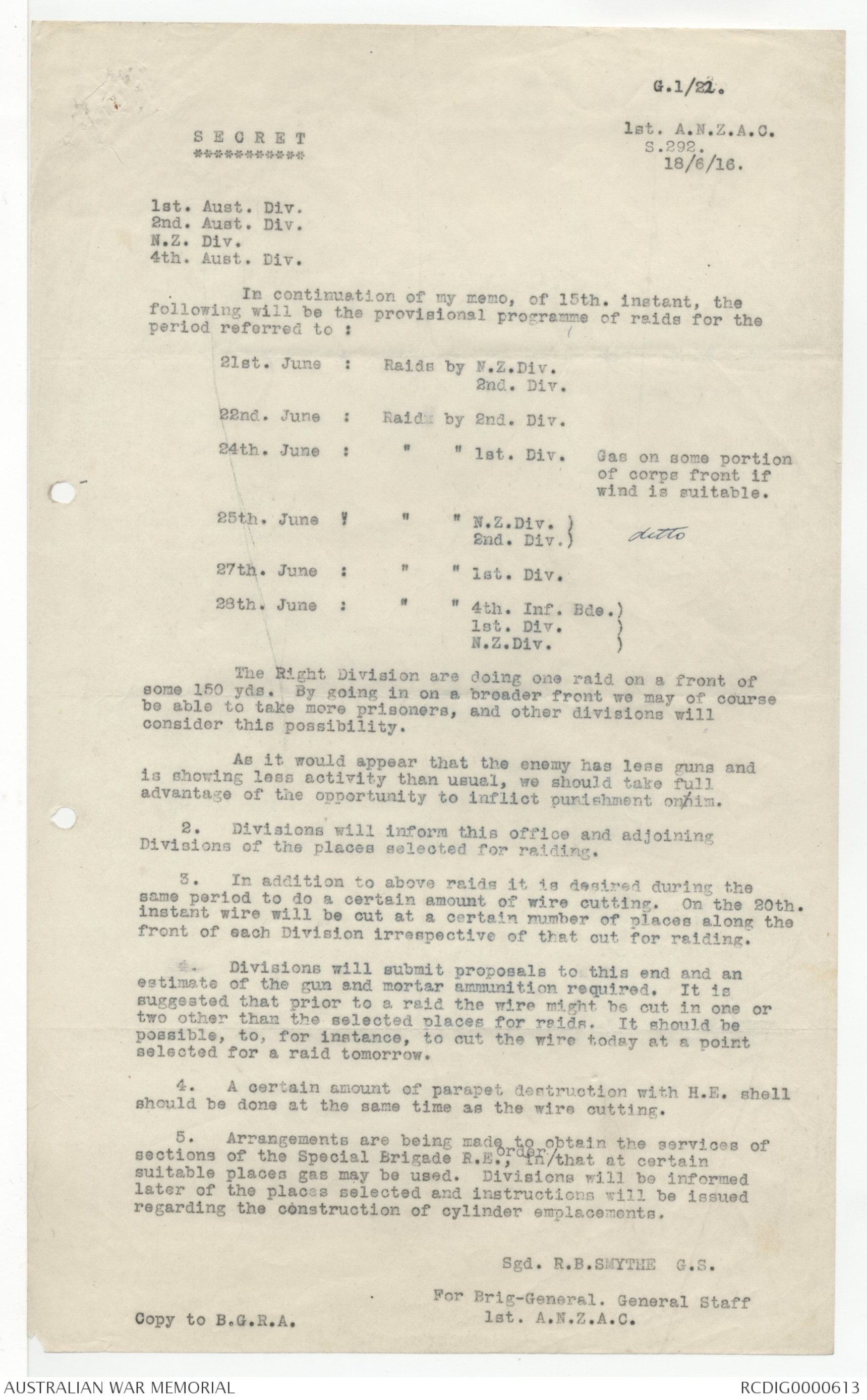
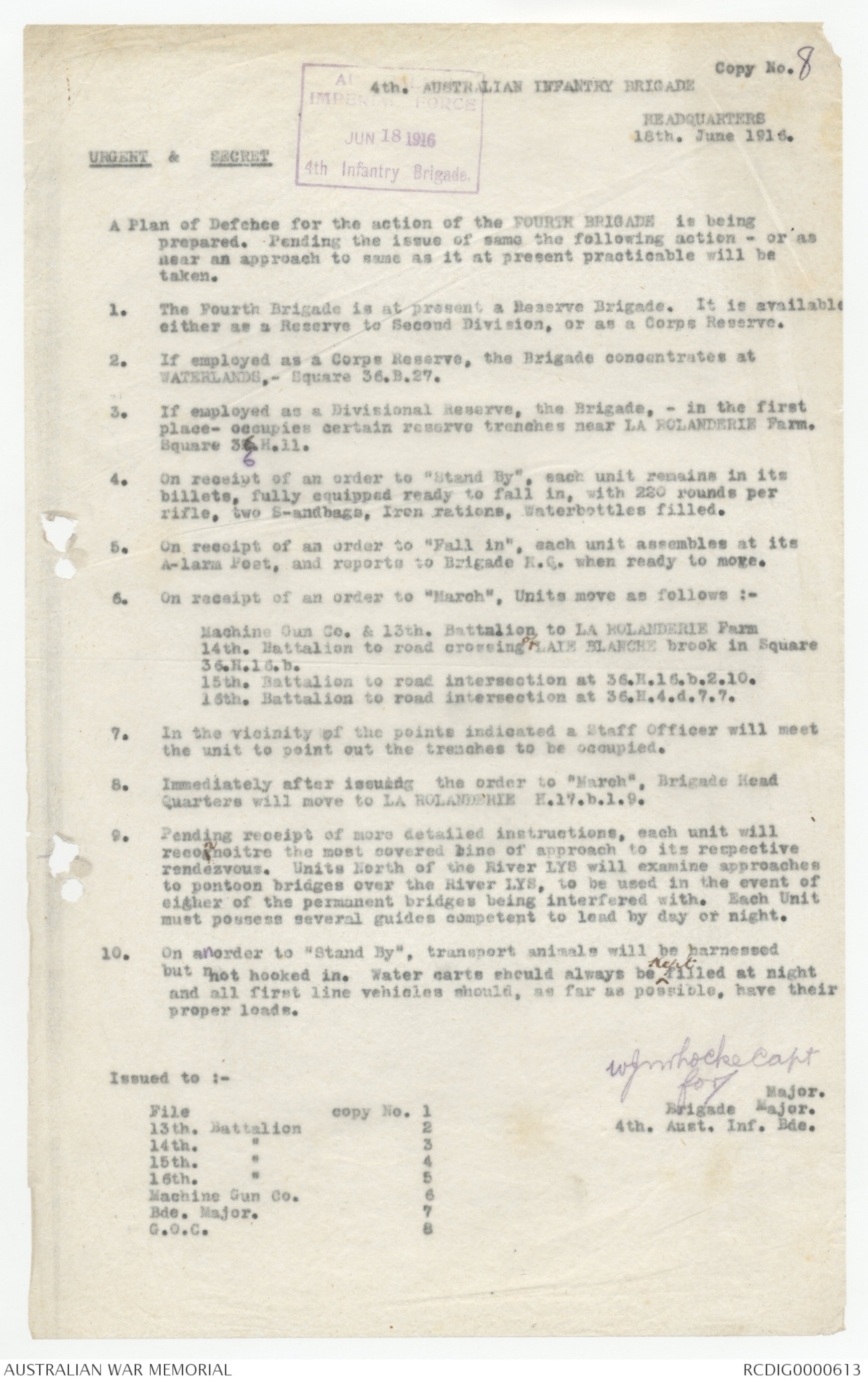
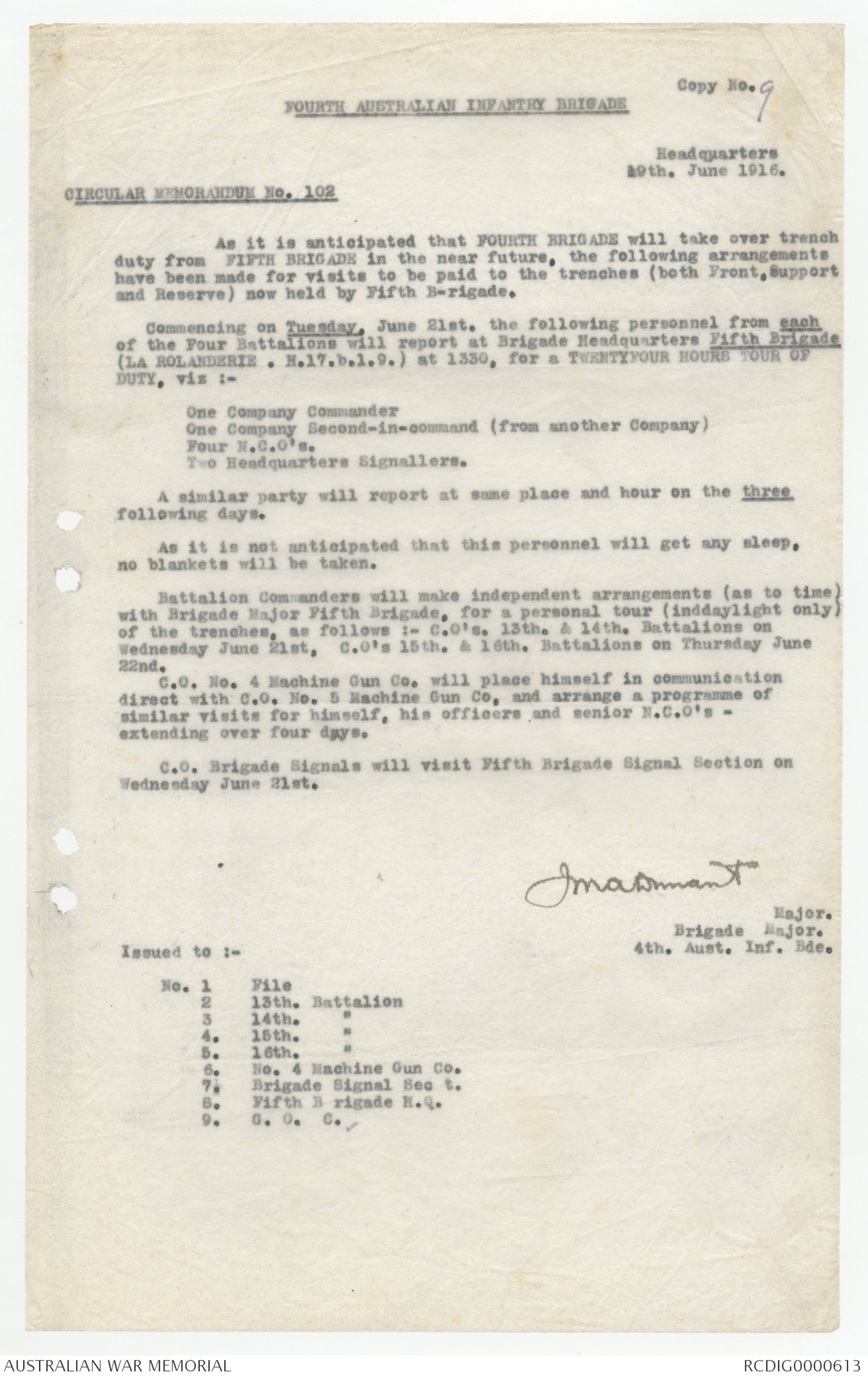
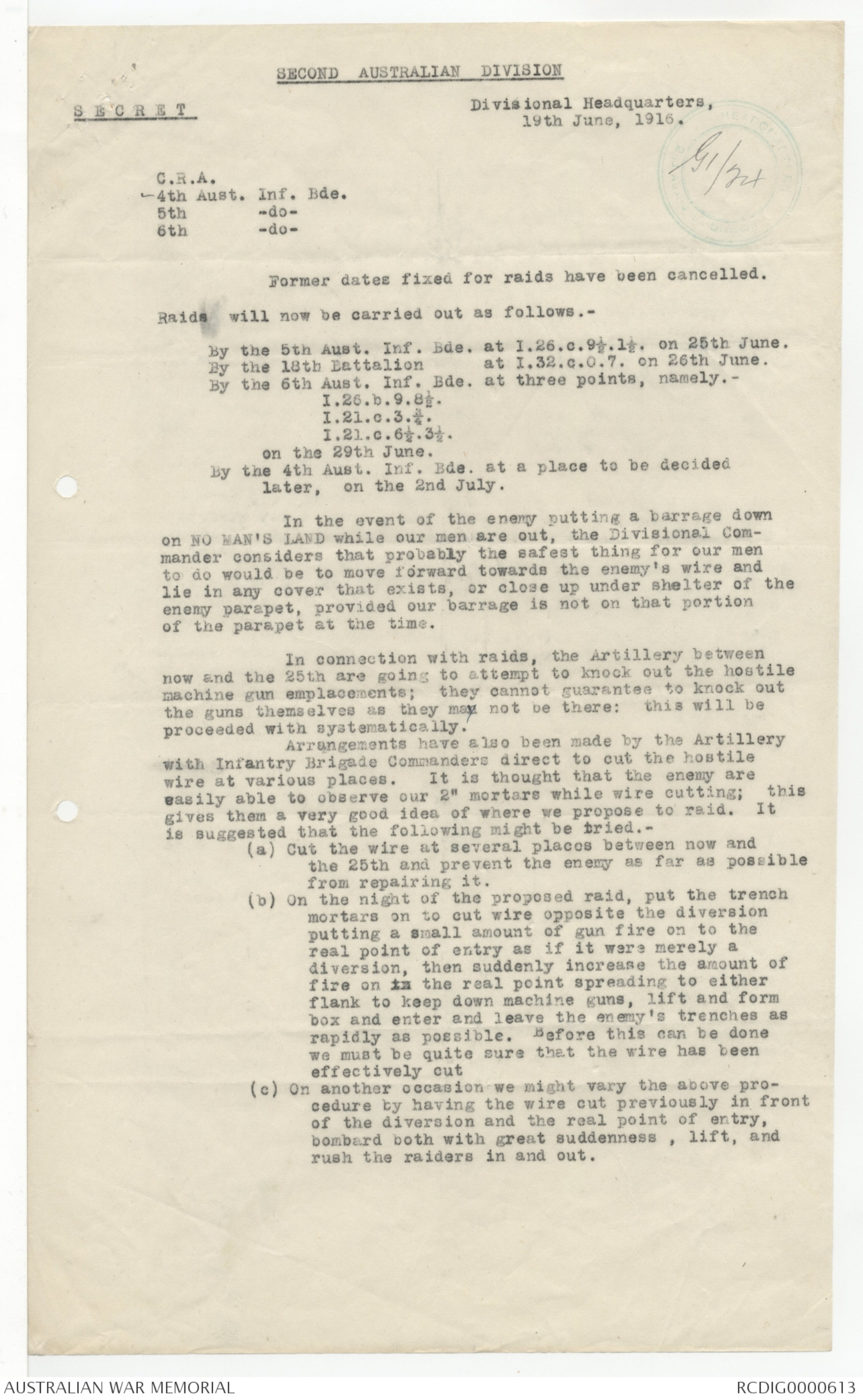
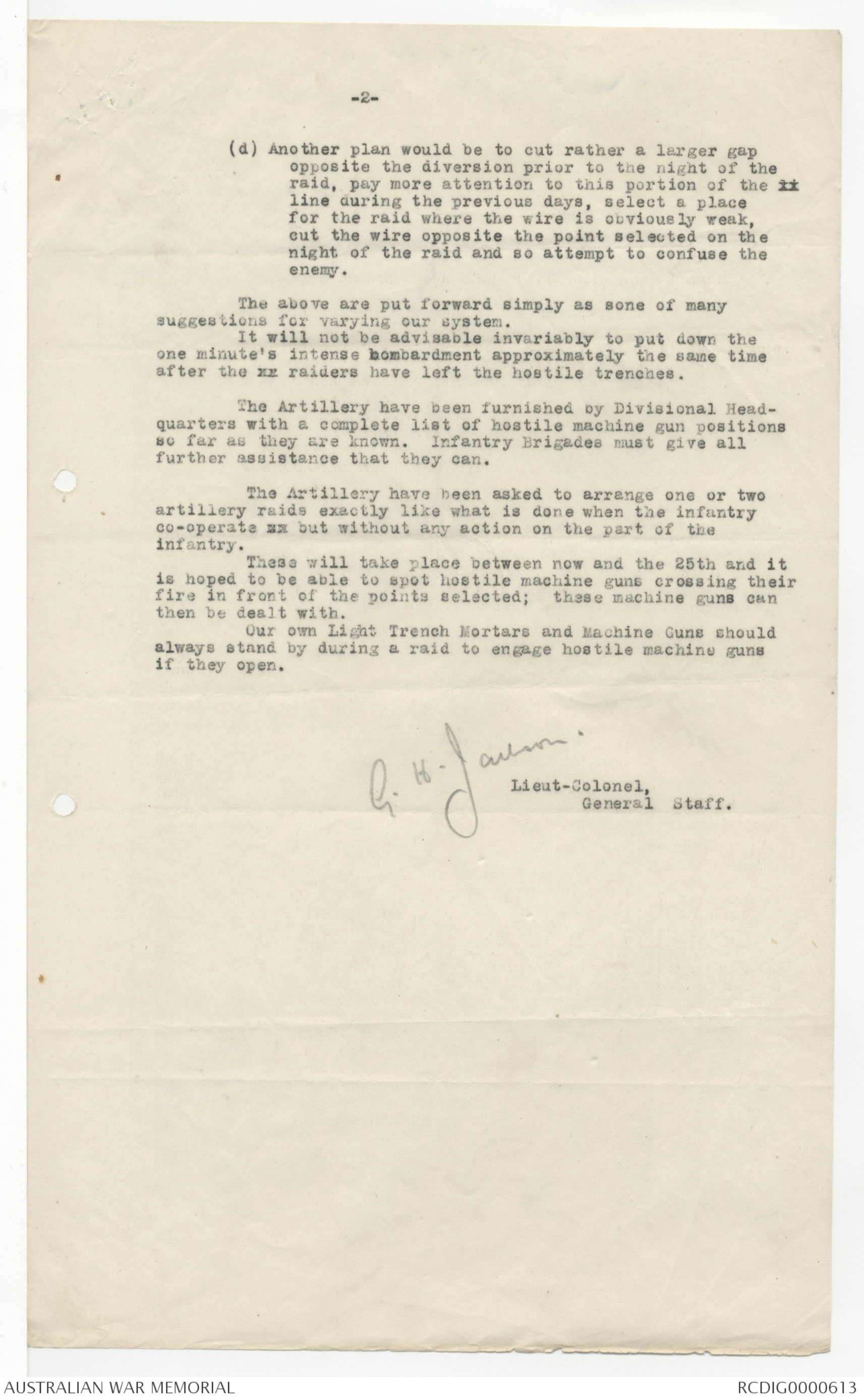
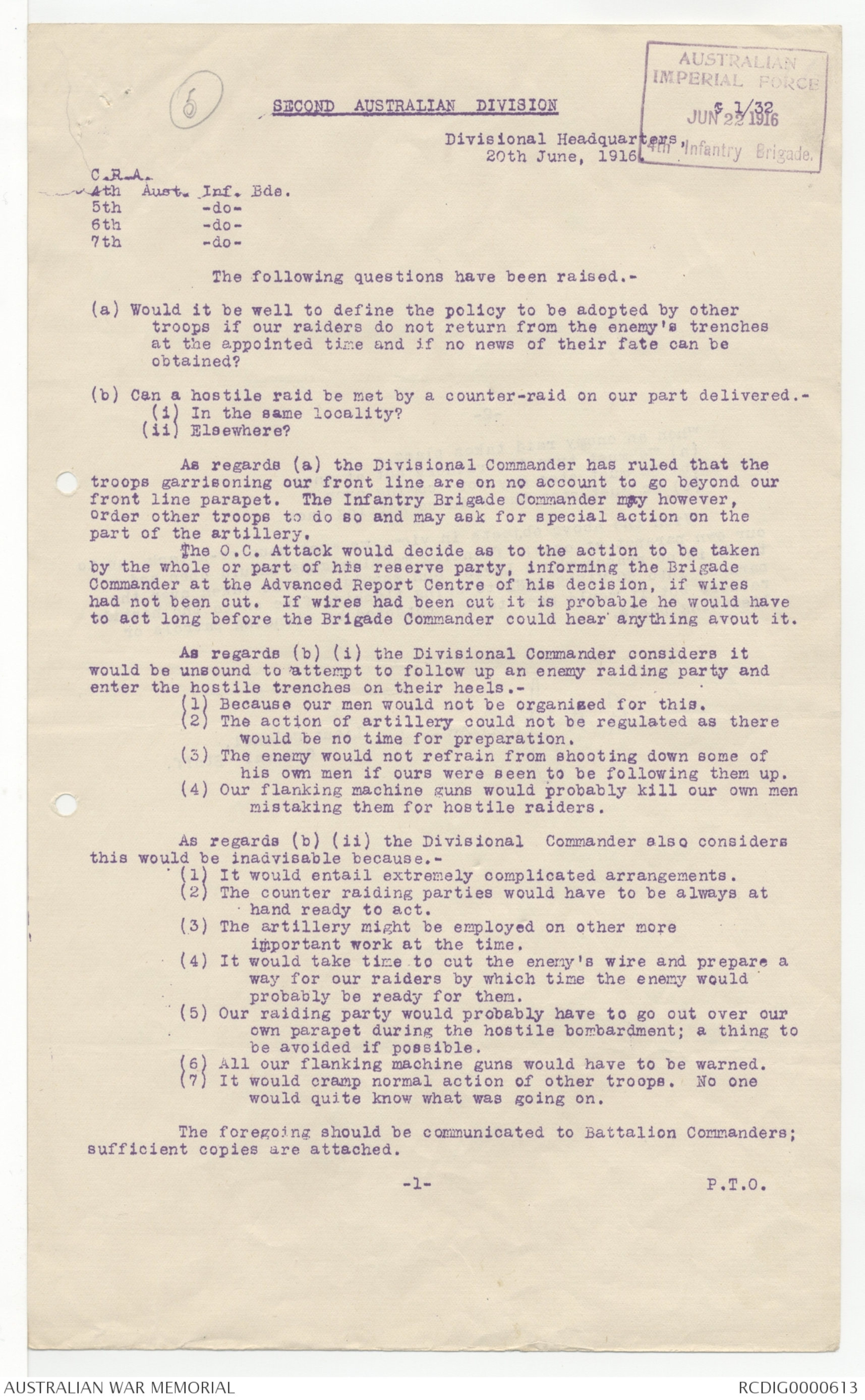
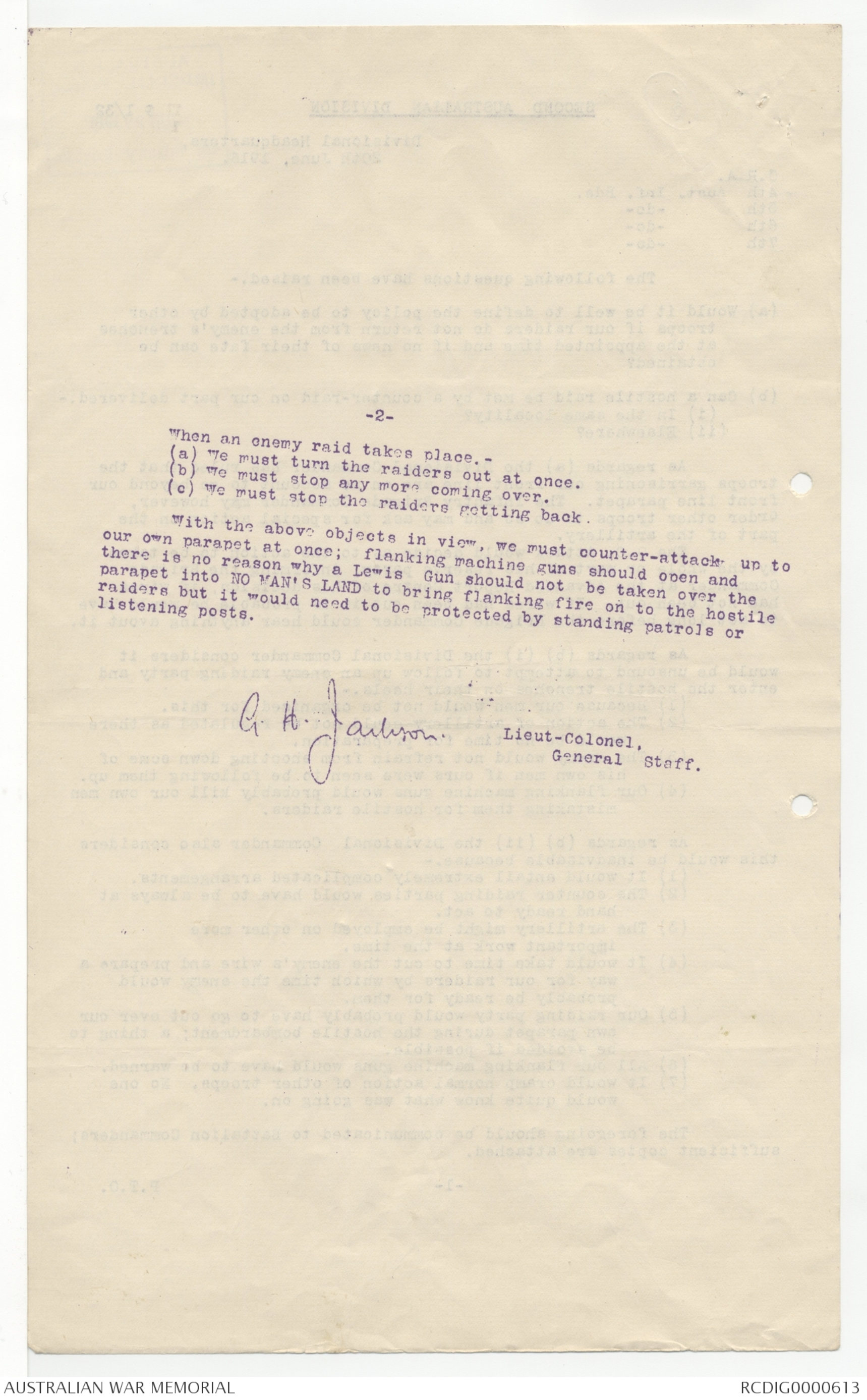
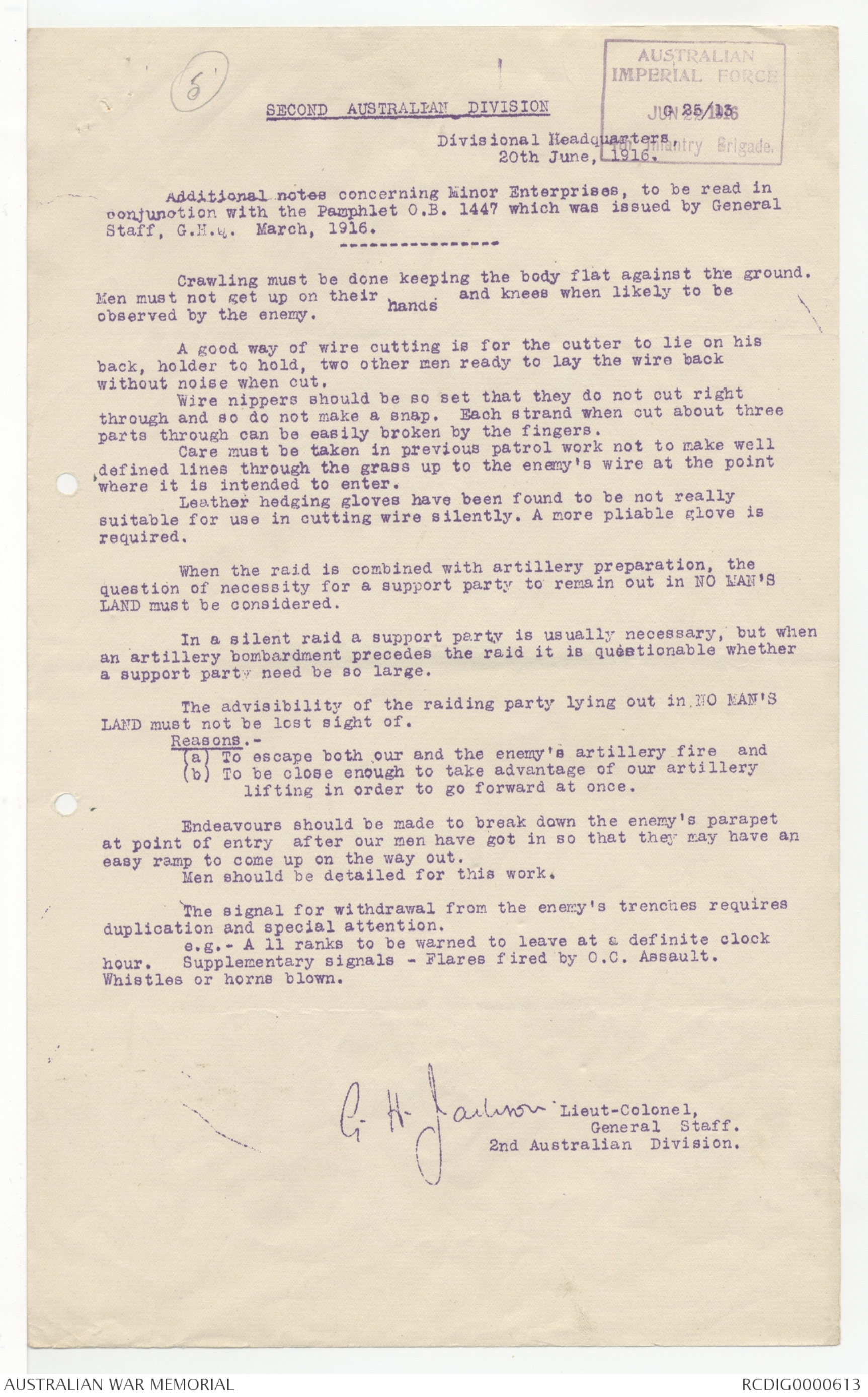
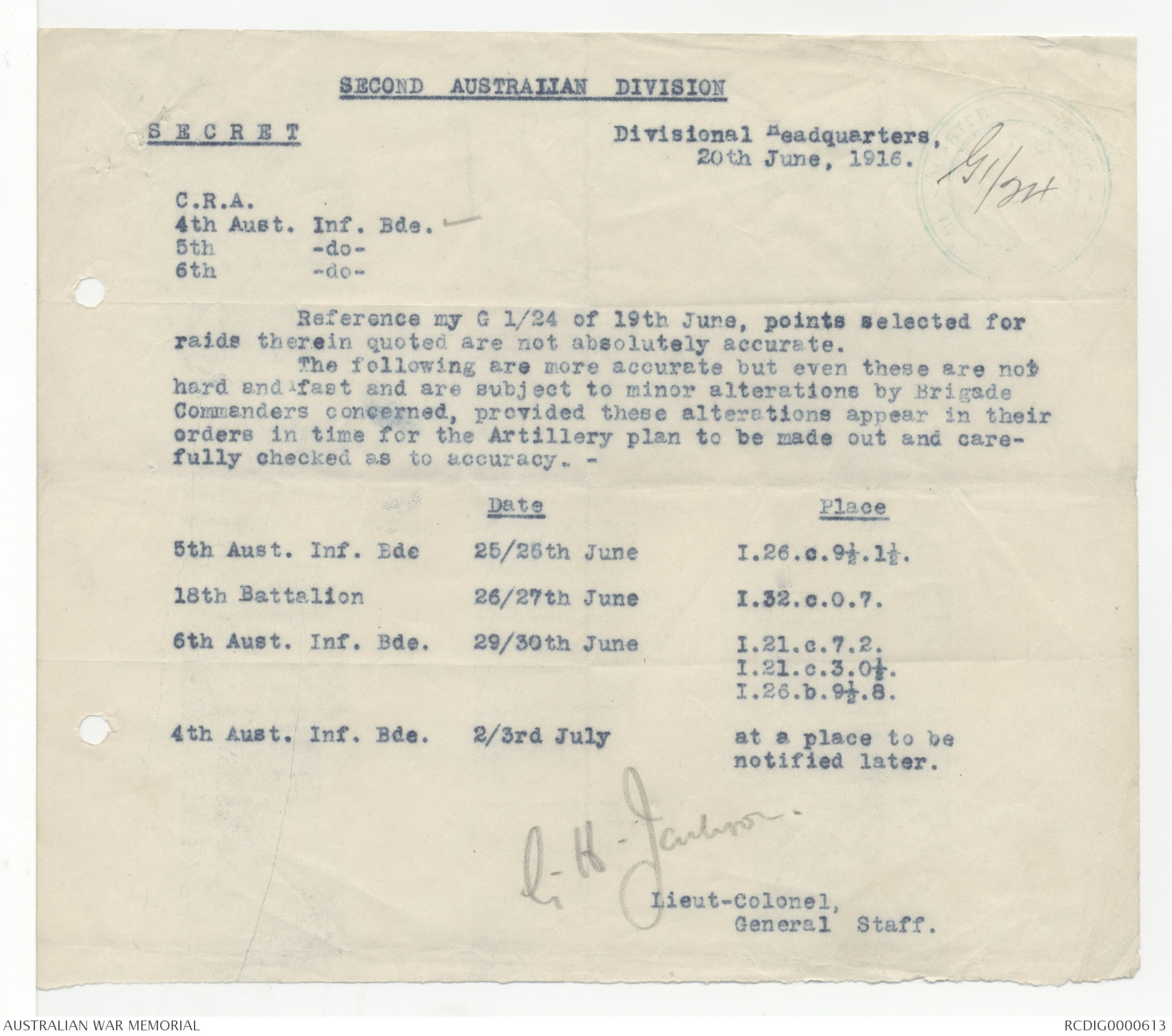
[*G1/22*]
SECOND AUSTRALIAN DIVISION
Secret
Very Urgent
Divisional Headquarters,
18th June 1916.
C.R.A.
4th Aust. Inf. Brigade
5th -do-
6th -do-
4th Aust. Division (for information).
The attached copy of letter received today from
Corps Headquarters is forwarded for your information.
The impossibility of the 2nd Australian Division
carrying out a raid on the 21st has been pointed out
to Corps Headquarters, as also the inadvisability of the
4th Infantry Brigade carrying out a raid on the 28th
June. It has been suggested that the raid on the 2nd
Australian Division front on the 28th June should be
carried out by a Company drawn from the 6th Brigade and that
the 4th Brigade should execute a raid later on, not earlier
than the 2nd July.
Brigade Commanders of the 5th and 6th Brigades will
arrange direct with the Divisional Artillery as to what
wire is to be cut on the 20th June. Seeing that the
Division has to submit proposals to the Corps concerning
this giving an estimate of the gun and mortar ammunition
required, it is essential that reports from the C.R.A.
after consulting the Infantry Brigade Commanders will
shall reach this office by noon on the 19th inst.
Infantry Brigade Commanders will decide in consultation
with the C.R.A. whether they wish to cut the wire one day
for a raid on the following day; there are advantages and
disadvantages in this and Infantry Brigade Commanders will
consider these in making their decision.
G.H.Jackson
Lieut-Colonel,
General Staff.
G.1/21
1st. A.N.Z.A.C.
S.292.
18/6/16.
SECRET
1st. Aust. Div.
2nd. Aust. Div.
N.Z. Div.
4th Aust. Div.
In continuation of my memo, of 15th. instant, the
following will be the provisional programme of raids for the
period referred to:
21st. June : Raids by N.Z. Div.
2nd. Div.
22nd. June : Raids by 2nd. Div.
24th. June : " " 1st. Div. Gas on some portion
of corps front if
wind is suitable.
25th. June : " " N.Z. Div. )
2nd. Div. ) ditto
27th. June : " " 1st. Div.
28th. June : " " 4th. Inf. Bde. )
1st. Div. )
N.Z. Div. )
The Right Division are doing one raid on a front of
some 150 yds. By going in on a broader front we may of course
be able to take more prisoners, and other divisions will
consider this possibility.
As it would appear that the enemy has less guns and
is showing less activity than usual, we should take full
advantage of the opportunity to inflict punishment on/him.
2. Divisions will inform this office and adjoining
Divisions of the places selected for raiding.
3. In addition to above raids it is desired during the
same period to do a certain amount of wire cutting. On the 20th.
instant wire will be cut at a certain number of places along the
front of each Division irrespective of that cut for raiding.
4. Divisions will submit proposals to this end and an
estimate of the gun and mortar ammunition required. It is
suggested that prior to a raid the wire might be cut in one or
two other than the selected places for raids. It should be
possible, to, for instance, to cut the wire today at a point
selected for a raid tomorrow.
4. A certain amount of parapet destruction with H.E. shell
should be done at the same time as the wire cutting.
5. Arrangements are being made to obtain the services of
sections of the Special Brigade R.E., in order that at certain
suitable places gas may be used. Divisions will be informed
later of the places selected and instructions will be issued
regarding the construction of cylinder emplacements.
Sgd. R. B. SMYTHE G.S.
For Brig-General. General Staff
1st. A.N.Z.A.C.
Copy to B.G.R.A.
Copy No. 8
4th. AUSTRALIAN INFANTRY BRIGADE
HEADQUARTERS
18th. June 1916.
AUSTRALIAN
IMPERIAL FORCES
JUN 18 1916
4th Infantry Brigade.
URGENT & SECRET
A Plan of Defence for the action of the FOURTH BRIGADE is being
prepared. Pending the issue of same the following action - or as
near an approach to same as it at present practicable will be
taken.
- The Fourth Brigade is at present a Reserve Brigade. It is available
either as a Reserve to Second Division, or as a Corps Reserve.
2. If employed as a Corps Reserve, the Brigade concentrates at
WATERLANDS, - Square 36.B.27.
3. If employed as a Divisional Reserve, the Brigade, - in the first
place - occupies certain reserve trenches near LA ROLANDERIE Farm.
Square 36.H.11.
4. On receipt of an order to "Stand By", each unit remains in its
billets, fully equipped ready to fall in, with 220 rounds per
rifle, two S-andbags, Iron rations, Waterbottles filled.
5. On receipt of an order to "Fall in", each unit assembles at its
A-larm Post, and reports to Brigade H.Q. when ready to move.
6. On receipt of an order to "March", Units move as follows :-
Machine Gun Co. & 13th. Battalion to LA ROLANDERIE Farm
14th. Battalion to road crossing of LAIE BLANCHE brook in Square
36.H.16.b.
15th. Battalion to road intersection at 36.H.16.b.2.10.
16th. Battalion to road intersection at 36.H.4.d.7.7.
7. In the vicinity of the points indicated a Staff Officer will meet
the unit to point out the trenches to be occupied.
8. Immediately after issuing the order to "March", Brigade Head
Quarters will move to LA ROLANDERIE H.17.b.1.9.
9. Pending receipt of more detailed instructions, each unit will
reconnoitre the most covered line of approach to its respective
rendezvous. Units North of the River LYS will examine approaches
to pontoon bridges over the River LYS, to be used in the event of
either of the permanent bridges being interfered with. Each Unit
must possess several guides competent to lead by day or night.
10. On an order to "Stand By", transport animals will be harnessed
but not hooked in. Water carts should always be kept filled at night
and all first line vehicles should, as far as possible, have their
proper loads.
WJMLocke Capt
for Major.
Brigade Major.
4th. Aust. Inf. Bde.
Issued to :-
File copy No. 1
13th. Battalion 2
14th. " 3
15th. " 4
16th. " 5
Machine Gun Co. 6
Bde. Major. 7
G.O.C. 8
Copy No. 9
FOURTH AUSTRALIAN INFANTRY BRIGADE
Headquarters
19th. June 1916.
CIRCULAR MEMORANDUM No. 102
As it is anticipated that FOURTH BRIGADE will take over trench
duty from FIFTH BRIGADE in the near future, the following arrangements
have been made for visits to be paid to the trenches (both Front, Support
and Reserve) now held by Fifth B-rigade.
Commencing on Tuesday, June 21st. the following personnel from each
of the Four Battalions will report at Brigade Headquarters Fifth Brigade
(LA ROLANDERIE. H.17.b.1.9.) at 1330, for a TWENTYFOUR HOURS TOUR OF
DUTY, viz :-
One Company Commander
One Company Second-in-command (from another Company)
Four N.C.O's.
Two Headquarters Signallers.
A similar party will report at same place and hour on the three
following days.
As it is not anticipated that this personnel will get any sleep,
no blankets will be taken.
Battalion Commanders will make independent arrangements (as to time)
with Brigade Major Fifth Brigade, for a personal tour (inddaylight only)
of the trenches, as follows :- C.O's 13th. & 14th. Battalions on
Wednesday June 21st., C.O's 15th. & 16th. Battalions on Thursday June
22nd.
C.O. No. 4 Machine Gun Co. will place himself in communication
direct with C.O. No. 5 Machine Gun Co, and arrange a programme of
similar visits for himself, his officers and senior N.C.O's -
extending over four days.
C.O. Brigade Signals will visit Fifth Brigade Signal Sections on
Wednesday June 21st.
J MA Durrant
Major.
Brigade Major.
4th. Aust. Inf. Bde.
Issued to :-
No. 1 File
2 13th. Battalion
3 14th. "
4. 15th. "
5. 16th. "
6. No. 4 Machine Gun Co.
7. Brigade Signal Sec t.
8. Fifth B rigade H.Q.
9. G.O.C. ✓
[*G1/24*]
SECOND AUSTRALIAN DIVISION
Divisional Headquarters,
19th June, 1916.
SECRET
C.R.A.
4th Aust. Inf. Bde.
5th -do-
6th -do-
Former dates fixed for raids have been cancelled.
Raids will now be carried out as follows :-
By the 5th Aust. Inf. Bde. at I.26.c.9½.1½. on 25th June.
By the 18th Battalion at I.32.c.0.7. on 26th June.
By the 6th Aust. Inf. Bde. at three points, namely. -
I.26.b.9.8½.
I.21.c.3¾.
I.21.c.6½.3½.
on the 29th June.
By the 4th Aust. Inf. Bde. at a place to be decided
later, on the 2nd July.
In the event of the enemy putting a barrage down
on NO MAN'S LAND while our men are out, the Divisional Commander
considers that probably the safest thing for our men
to do would be to move forward towards the enemy's wire and
lie in any cover that exists, or close up under shelter of the
enemy parapet, provided our barrage is not on that portion
of the parapet at the time.
In connection with raids, the Artillery between
now and the 25th are going to attempt to knock out the hostile
machine gun emplacements; they cannot guarantee to knock out
the guns themselves as they may not be there: this will be
proceeded with systematically.
Arrangements have also been made by the Artillery
with Infantry Brigade Commanders direct to cut the hostile
wire at various places. It is thought that the enemy are
easily able to observe our 2" mortars while wire cutting; this
gives them a very good idea of where we propose to raid. It
is suggested that the following might be tried. -
(a) Cut the wire at several places between now and
the 25th and prevent the enemy as far as possible
from repairing it.
(b) On the night of the proposed raid, put the trench
mortars on to cut wire opposite the diversion
putting a small amount of gun fire on to the
real point of entry as if it were merely a
diversion, then suddenly increase the amount of
fire on in the real point spreading to either
flank to keep down machine guns, lift and form
box and enter and leave the enemy's trenches as
rapidly as possible. Before this can be done
we must be quite sure that the wire has been
effectively cut
(c) On another occasion we might vary the above
procedure by having the wire cut previously in front
of the diversion and the real point of entry,
bombard both with great suddenness, lift, and
rush the raiders in and out.
-2-
(d) Another plan would be to cut rather a larger gap
opposite the diversion prior to the night of the
raid, pay more attention to this portion of the li
line during the previous days, select a place
for the raid where the wire is obviously weak,
cut the wire opposite the point selected on the
night of the raid and so attempt to confuse the
enemy.
The above are put forward simply as sone of many
suggestions for varying our system.
It will not be advisable invariably to put down the
one minute's intense bombardment approximately the same time
after the xx raiders have left the hostile trenches.
The Artillery have been furnished by Divisional Headquarters
with a complete list of hostile machine gun positions
so far as they are known. Infantry Brigade must give all
further assistance that they can.
The Artillery have been asked to arrange one or two
artillery raids exactly like what is done when the infantry
co-operate xx but without any action on the part of the
infantry.
These will take place between now and the 25th and it
is hoped to be able to spot hostile machine guns crossing their
fire in front of the point selected; these machine guns can
then be dealt with.
Our own Light Trench Mortars and Machine Guns should
always stand by during a raid to engage hostile machine guns
if they open.
G.H. Jackson.
Lieut-Colonel,
General Staff.
[*5*]
AUSTRALIAN
IMPERIAL FORCE
[[?]] 1/32
JUN 22 1916
4th Infantry Brigade
SECOND AUSTRALIAN DIVISION
Divisional Headquarters,
20th June, 1916.
C.R.A.
4th Aust. Inf. Bde.
5th -do-
6th -do-
7th -do-
The following questions have been raised. -
(a) Would it be well to define the policy to be adopted by other
troops if our raiders do not return from the enemy's trenches
at the appointed time and if no news of their fate can be
obtained?
(b) Can a hostile raid be met by a counter-raid on our part delivered. -
(i) In the same locality?
(ii) Elsewhere?
As regards (a) the Divisional Commander has ruled that the
troops garrisoning our front line are on no account to go beyond our
front line parapet. The Infantry Brigade Commander may however,
order other troops to do so and may ask for special action on the
part of the artillery.
The O.C. Attack would decide as to the action to be taken
by the whole or part of his reserve party, informing the Brigade
Commander at the Advanced Report Centre of his decision, if wires
had not been cut. If wires had been cut it is probable he would have
to act long before the Brigade Commander could hear anything avout it.
As regards (b) (i) the Divisional Commander considers it
would be unsound to attempt to follow up an enemy raiding party and
enter the hostile trenches on their heels. -
(1) Because our men would not be organised for this.
(2) The action of artillery could not be regulated as there
would be not time for preparation.
(3) The enemy would not refrain from shooting down some of
his own men if ours were seen to be following them up.
(4) Our flanking machine guns would probably kill our own men
mistaking them for hostile raiders.
As regards (b) (ii) the Divisional Commander also considers
this would be inadvisable because. -
(1) It would entail extremely complicated arrangements.
(2) The counter raiding parties would have to be always at
hand ready to act.
(3) The artillery might be employed on other more
important work at the time.
(4) It would take time to cut the enemy's wire and prepare a
way for our raiders by which time the enemy would
probably be ready for them.
(5) Our raiding party would probably have to go out over our
own parapet during the hostile bombardment; a thing to
be avoided if possible.
(6) All our flanking machine guns would have to be warned.
(7) It would cramp normal action of other troops. No one
would quite know what was going on.
The foregoing should be communicated to Battalion Commanders;
sufficient copies are attached.
-1- P.T.O.
-2-
When an enemy raid takes place, -
(a) We must turn the raiders out at once.
(b) We must stop any more coming over.
(c) We must stop the raiders getting back.
With the above objects in view, we must counter-attack up to
our own parapet at once; flanking machine guns should open and
there is no reason why a Lewis Gun should not be taken over the
parapet into NO MAN'S LAND to bring flanking fire on to the hostile
raiders but it would need to be protected by standing patrols or
listening posts.
G. H. Jackson.
Lieut-Colonel,
General Staff.
[*5*]
AUSTRALIAN
IMPERIAL FORCE
G25/13
JUN 22 1916
4th Infantry Brigade
SECOND AUSTRALIAN DIVISION
Divisional Headquarters,
20th June, 1916.
Additional notes concerning Minor Enterprises, to be read in
conjunction with the Pamphlet O.B. 1447 which was issued by General
Staff, G.H.Q. March, 1916.
Crawling must be done keeping the body flat against the ground.
Men must not get up on their hands and knees when likely to be
observed by the enemy.
A good way of wire cutting is for the cutter to lie on his
back, holder to hold, two other men ready to lay the wire back
without noise when cut.
Wire nippers should be so set that they do not cut right
through and so do not make a snap. Each strand when cut about three
parts through can be easily broken by the fingers.
Care must be taken in previous patrol work not to make well
defined lines through the grass up to the enemy's wire at the point
where it is intended to enter.
Leather hedging gloves have been found to be not really
suitable for use in cutting wire silently. A more pliable glove is
required.
When the raid is combined with artillery preparation, the
question of necessity for a support party to remain out in NO MAN'S
LAND must be considered.
In a silent raid a support party is usually necessary, but when
an artillery bombardment precedes the raid it is questionable whether
a support party need be so large.
The advisibility of the raiding party lying out in NO MAN'S
LAND must not be lost sight of.
Reasons.-
(a) To escape both our and the enemy's artillery fire and
(b) To be close enough to take advantage of our artillery
lifting in order to go forward at once.
Endeavours should be made to break down the enemy's parapet
at point of entry after our men have got in so that they may have an
easy ramp to come up on the way out.
Men should be detailed for this work.
The signal for withdrawal from the enemy's trenches requires
duplication and special attention.
e.g.- A ll ranks to be warned to leave at a definite clock
hour. Supplementary signals - Flares fired by O.C. Assault.
Whistles or horns blown.
G.H. Jackson
Lieut-Colonel,
General Staff.
2nd Australian Division.
[*G1/24*]
SECOND AUSTRALIAN DIVISION
Divisional Headquarters,
20th June, 1916.
SECRET
C.R.A.
4th Aust. Inf. Bde. ✓
5th -do-
6th -do-
Reference my G 1/24 of 19th June, points selected for
raids therein quoted are not absolutely accurate.
The following are more accurate but even these are not
hard and fast and are subject to minor alterations by Brigade
Commanders concerned, provided these alterations appear in their
orders in time for the Artillery plan to be made out and carefully
checked as to accuracy. -
Date Place
5th Aust. Inf. Bde 25/26th June I.26.c.9½.1½.
18th Battalion 26/27th June I.32.c.0.7.
6th Aust. Inf. Bde. 29/30th June I.21.c.7.2.
I.21.c.3.0½.
I.26.b.9½.8.
4th. Aust. Inf. Bde. 2/3rd July at a place to be
notified later.
G. H. Jackson.
Lieut-Colonel,
General Staff.
 Deb Parkinson
Deb ParkinsonThis transcription item is now locked to you for editing. To release the lock either Save your changes or Cancel.
This lock will be automatically released after 60 minutes of inactivity.